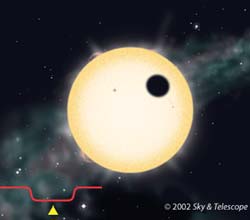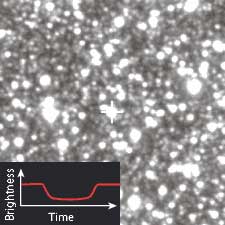
Astronomers detect a planetary transit by monitoring the light from a star over a long period. If the brightness dips slightly and the dip has a flat bottom, it may be caused by the passing silhouette of an orbiting planet. This only occurs when we happen to be very near the plane of the exoplanet's orbit. Click on image for an animated movie.
S&T illustration by Steven Simpson.
For the first time, astronomers have discovered a bunch of new extrasolar planets — and perhaps other small, dark objects as well — by detecting the slight dimming they cause when passing across the face of a star.
The OGLE-III experiment monitored 5 million Milky Way stars toward the galaxy's center for 32 nights. Andrzej Udalski (Warsaw University Observatory) reports that out of this vast sample, 52,000 main-sequence stars roughly similar to the Sun met the study's key criterion: their brightnesses were measured many times with high (1.5 percent) precision. Of these stars, 46 clearly showed signs of smaller objects transiting across their faces. And 43 displayed more than one transit event, thereby revealing the companion object's orbital period — generally 1 to 6 days.
The dark, transiting silhouettes range in size from about 1 to 4 times the diameter of Jupiter, as indicated by the stars' loss of light. The larger ones must be dim red-dwarf stars, judging by their size. But the smaller ones could be either very small red dwarfs, lower-mass brown dwarfs, or true giant planets. All these types of objects have about the same physical size (1 to 2 Jupiter diameters) despite their wide range of masses (from roughly 1 to more than 100 Jupiters).

Deep in the rich star fields around the Milky Way's central bulge, a 14th-magnitude star (in white cross at center) shows a tiny, flat-bottomed dip in brightness every 2.81 days — probably the sign of something twice the size of Jupiter crossing its face.
Courtesy A. Udalski and colleagues.
"Future determination of the amplitude of radial (line-of-sight) velocity changes will establish their masses," write Udalski and his eight colleagues, "and will confirm or refute the reality of the so called 'brown-dwarf desert,'" the apparent scarcity of brown dwarfs that orbit stars closely. In addition, the more massive of the newly discovered objects will provide new data badly needed to calibrate the poorly known relation between red dwarfs' masses and sizes.
The project's success bodes well for future, larger planet-transit searches, both from the ground and from space. The most ambitious being planned is NASA's Kepler mission, due for launch in 2005. Its designers say Kepler should be able to detect hundreds of planets as small as Earth or even smaller — assuming, of course, they exist.
 0
0
Comments
You must be logged in to post a comment.